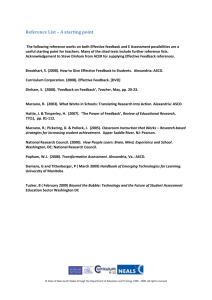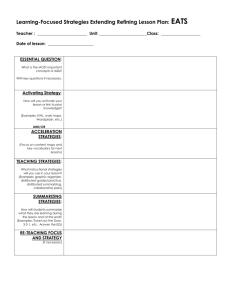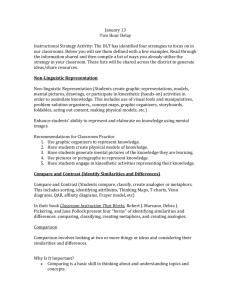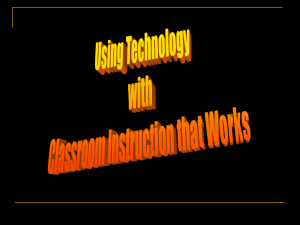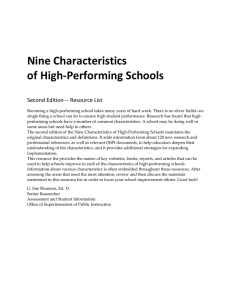Designing with the End in Mind
advertisement
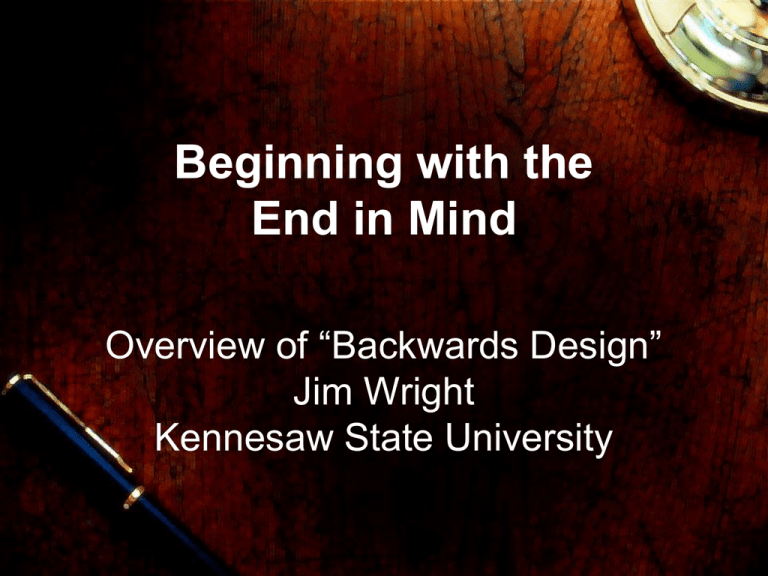
Beginning with the End in Mind Overview of “Backwards Design” Jim Wright Kennesaw State University Caveat: We only have 30 min Information taken from the: McTighe, J., & Wiggins, G. (2005). Understanding by Design (2nd Edition) (ASCD). Alexandria, VA: Prentice Hall. Why? • Do we often plan by activity? • Because it is the right thing to do • and . . . Your Performance Evaluation A. Curriculum and Planning – The teacher makes decisions about planning that demonstrate a deep understanding of grade level content knowledge, pedagogy, and GPS or State-approved curriculum implementation by appropriately planning for what students are expected to know, understand, and be able to do Stages of Backwards Design 1. Identify desired results 2. Determine acceptable evidence 3. Plan learning experiences & instruction Establishing Priorities Knowledge that is worth being familiar with Worth being familiar with Important to know and do Knowledge and skills that are important to know and do “Enduring” understanding Understandings that are enduring – What do you want you students to remember in 10 years? Six Facets of Understanding •Explain - provide thorough, •Perspective - can see and supported, and justifiable accounts of phenomena, facts and data hear points of view through critical eyes and ears; see the big picture. •Interpret - tell meaningful stories; •Empathize - find value in what offer apt translations; provide a revealing historical or personal dimension to ideas and events; make it personal or accessible through images, anecdotes, analogies, and models. others might find odd, alien, or implausible; perceive sensitively on the basis of prior direct experience. •Apply - effectively use and adapt the personal style, prejudices, projections, and habits of mind that both shape and impede our own understanding; having an awareness of what one does not understand and why understanding is so hard what is known in diverse contexts. •Self-Knowledge - perceive Curricular Priorities and Assessment Methods Assessment Types Traditional quizzes and tests Paper-pencil Selected-response Constructed-response Performance tasks and projects Open-ended Complex Authentic Worth being familiar with Important to know and do “Enduring” understanding Stage 3 big idea: E F F E C T I V E and E N G A G I N G Let’s See It In Action • Chemistry Class SCSh6. Students will communicate scientific investigations and information clearly. a. Write clear, coherent laboratory reports related to scientific investigations. b. Write clear, coherent accounts of current scientific issues, including possible alternative interpretations of the data. c. Use data as evidence to support scientific arguments and claims in written or oral presentations. d. Participate in group discussions of scientific investigation and current scientific issues. Brainstorm with the Three Stages 1. Identify desired results 2. Determine acceptable evidence 3. Plan learning experiences & instruction Instructional Strategies • Marzano, R. J., Pickering, D. J., & Pollock, J. E. (2004). Classroom Instruction that Works: Research-Based Strategies for Increasing Student Achievement (ASCD). Alexandria, VA: Prentice Hall. Strategies 1. Identifying similarities and differences 2. Summarizing and note taking 3. Reinforcing effort and providing recognition 4. Homework and practice 5. Nonlinguistic representations 6. Cooperative learning 7. Setting objectives and providing feedback 8. Generating and testing hypotheses 9. Cues, questions, and advance organizers Similarities & Differences COMPARING: Identifying similarities & differences between or among things or ideas. CLASSIFYING: Grouping things that are alike into categories based on their characteristics. CREATING ANALOGIES: Identifying relationships between pairs of concepts (Relationships between relationships) CREATING METAPHORS: Identifying a general pattern in a specific topic then finding another topic that is different, but has the same general pattern. Summarizing • To effectively summarize, students must delete some information, substitute some information and keep some information. • To effectively delete, substitute, and keep information, students must analyze the information at a fairly deep level. • Being aware of the explicit structure of information is an aid to summarizing information. Providing Recognition • Rewards do not necessarily have a negative effect on intrinsic motivation. • Reward is most effective when it is contingent on the attainment of some standard of performance. • Abstract symbolic recognition is more effective than tangible rewards.
